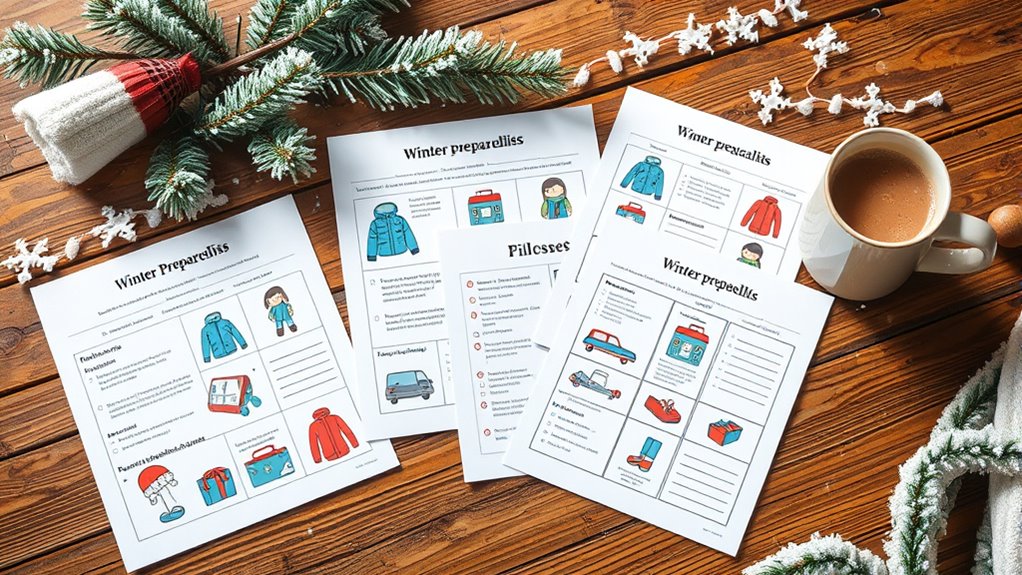If you want reliable winter preparedness checklists, I recommend the Essential Winter Freeze Checklist & Prep Book for home safety and the Backcountry Access Field Book for outdoor adventures. The checklist offers thorough coverage, large print, and organization, while the field book is waterproof and perfect for winter backcountry trips. Both are easy to customize and durable for harsh conditions. Keep exploring further, and you’ll find how these tools can help keep you safe and cozy all season long.
Key Takeaways
- Choose printable checklists with large fonts, clear sections, and icons for easy use during stressful winter emergencies.
- Prioritize durable, waterproof materials or PDFs that can be printed on weather-resistant paper for outdoor use.
- Ensure the checklists cover essential topics like emergency contacts, supplies, property safety, and seasonal hazards.
- Look for customizable, fillable formats that allow updates and personal notes for tailored winter preparedness.
- Opt for cost-effective options like printable PDFs that combine comprehensive coverage with affordability and ease of use.
Essential Winter Freeze Checklist and Preparation Book

If you’re looking for a thorough guide to prepare for winter freezes, the Essential Winter Freeze Checklist and Preparation Book is an excellent choice. I found it incredibly helpful for reducing panic and planning effectively. The large print makes it easy to write in, and with 65 pages, it covers everything from evacuation plans to insurance contacts. It also includes sections on equipment readiness and hazard checks, ensuring I don’t overlook anything. Designed specifically for winter emergencies, it encourages careful handling and safety. Plus, the personal info pages help keep crucial details organized. Overall, it’s a practical tool to stay safe and prepared during harsh winter conditions.
Best For: individuals and families seeking a comprehensive, easy-to-use guide to prepare effectively for winter freeze emergencies and ensure safety during harsh winter conditions.
Pros:
- Large print size (8.5 x 11 inches) makes writing and reading easy for all users
- Covers a wide range of topics including evacuation, insurance, supplies, and hazard assessment for thorough preparation
- Includes personal information sections and safety notes to help organize critical details and promote careful handling
Cons:
- 65 pages may be more detailed than some users need for quick reference
- Paperback format might be less durable over long-term use in rugged conditions
- Focused specifically on winter freezes, limiting applicability to other types of emergencies
Backcountry Access Field Book

The Backcountry Access Field Book is an essential tool designed for serious backcountry enthusiasts and avalanche professionals who need a reliable, waterproof resource for snow study and decision-making. I use it to record trip plans, snow profiles, and observations in wet conditions without worry. Its water-resistant pages and compact size make it perfect for field use, weighing just 3.2 ounces. The structured pages follow AAA and AIARE standards, helping me make informed decisions on terrain, snowpack, and weather. This durable, easy-to-carry book ensures I stay organized and safe during backcountry adventures, especially when conditions are challenging.
Best For: serious backcountry enthusiasts and avalanche professionals seeking a durable, waterproof snow study tool for informed decision-making in challenging conditions.
Pros:
- Water-resistant pages ensure durability and reliable data collection in wet weather
- Structured design aligned with AAA and AIARE standards supports effective snow and terrain assessments
- Compact, lightweight (3.2 oz) design makes it easy to carry during backcountry trips
Cons:
- Limited to 50 pages, which may require additional notebooks for extended trips
- Uses a pencil for writing, which may smudge or be less convenient in cold conditions
- Slightly higher price point compared to standard field notebooks
Factors to Consider When Choosing a Winter Preparedness Checklist Printable

When choosing a winter preparedness checklist printable, I look for one that covers all essential topics clearly and thoroughly. It’s also important that it’s easy to customize and understand at a glance, so I don’t miss any key steps. finally, I consider its durability and how accessible it is, especially if I need quick access during emergencies.
Content Relevance and Completeness
How can you guarantee that a winter preparedness checklist printable is truly effective? First, ensure it covers all critical areas like emergency contacts, supplies, and property safety to offer thorough guidance. It should be specifically tailored for winter freeze events, addressing seasonal risks like power outages and frozen pipes. The content must be current, aligning with the latest safety standards and disaster management practices. Additionally, a good checklist provides clear, step-by-step actions that are easy to reference during emergencies. Lastly, verify that the printable format allows for easy updates and note-taking, so you can personalize it as needed. When these elements come together, you’ll have a solid, relevant, and complete resource to keep you prepared and safe during the winter months.
Ease of Customization
Choosing a winter preparedness checklist printable that’s easy to customize is essential for staying prepared. A adaptable checklist allows me to tailor it to my specific needs and circumstances, making it more effective. I look for formats that support easy editing, such as PDF fillable forms or printable paper templates I can write on by hand. This flexibility helps me add or remove items based on my local climate, home features, and personal priorities. It also encourages me to review and update the list regularly, ensuring I stay current with safety measures and supplies. A customizable checklist keeps me engaged and confident that I’ve addressed all relevant safety concerns for my environment, making winter preparedness more manageable and comprehensive.
Visual Layout and Clarity
A clear and well-organized visual layout is essential for a winter preparedness checklist printable, especially when I need to quickly find specific items during stressful situations. Organized sections help me locate tasks efficiently, saving valuable time. Large, legible fonts improve readability, even in low-light or tense moments. Using icons or color coding helps me instantly identify the importance or category of each task, reducing confusion. Adequate spacing between items prevents clutter and makes handwritten notes clearer. Consistent formatting and clear headings enhance overall clarity, allowing me to navigate the checklist effortlessly. When the layout is thoughtfully designed, it becomes a practical tool I can rely on in emergencies, ensuring I don’t overlook critical steps while remaining calm and focused.
Durability and Material Quality
Selecting a durable winter preparedness checklist is essential, especially since it needs to withstand harsh conditions and frequent handling. High-quality, tear-resistant paper or laminated materials are vital for durability, as they resist moisture and rough use. Waterproof or water-resistant options are a must if you plan to use the checklist outdoors or in snowy, wet environments, preventing damage from moisture. Heavyweight paper or laminated pages help prevent tearing and wrinkling, ensuring the checklist stays intact during field assessments. Additionally, choosing materials with UV protection is wise, as it guards against fading or deterioration caused by sunlight exposure. Overall, investing in a checklist made from sturdy, weather-resistant materials guarantees it remains legible and functional throughout the winter season, providing reliable support when you need it most.
Accessibility and Usability
To guarantee your winter preparedness checklist is truly useful, it needs to be easy to read and navigate, even in stressful situations. I recommend choosing a large print format, like 8.5 x 11 inches, to accommodate anyone with visual impairments. Look for printable checklists with clear sections and labels that allow for quick reference. Waterproof pages or digital formats are essential for durability in snowy or wet conditions, ensuring your checklist remains intact. Simple language and icons help facilitate rapid understanding during emergencies. Additionally, verify that the printable version works across various devices and printers, making it accessible to everyone in your household. Prioritizing usability ensures your checklist is practical and effective when it matters most.
Affordability and Value
Choosing an affordable winter preparedness checklist means finding a balance between thorough coverage and a reasonable price. I look for checklists that offer detailed, essential information without the need for extra purchases or subscriptions. Comparing costs, printable checklists are often more budget-friendly than digital apps or professional services, providing good value. I also consider the durability of the printable—high-quality paper and clear layouts ensure it lasts through multiple winters. Features like space for notes or customization options at a reasonable price add extra value, helping me personalize my prep. Ultimately, I want a checklist that covers everything I need without overspending, making sure I get the best bang for my buck while staying safe and cozy during winter storms.
Frequently Asked Questions
Can These Printables Be Customized for Specific Needs?
I love that these printables can be customized to fit your specific needs. You can easily add or remove items based on your home, climate, or personal preferences. Whether you want to include extra emergency supplies or focus on cozy winter activities, these checklists are flexible. Just print, modify, and make them your own, ensuring you’re fully prepared and comfortable throughout the winter season.
Are the Checklists Suitable for Families or Only Individuals?
Absolutely, these checklists are like a warm blanket for families too. I designed them to be flexible, so you can tailor them to fit your family’s unique needs. Whether you’re juggling kids’ gear or pet supplies, these printables can be customized easily. Think of them as a cozy, organized toolkit that keeps everyone safe and snug during winter’s chill, no matter the size of your crew.
How Often Should I Update My Winter Preparedness Printables?
You should update your winter preparedness printables at least once a year, ideally before the cold weather hits. I personally check mine in late fall to verify everything is current, like contact info, supplies, and safety plans. If there are any changes in your household or local conditions, update more frequently. Staying proactive helps me feel confident and ready to handle winter challenges comfortably and safely.
Do Printable Checklists Include Emergency Contact Information?
Absolutely, printable checklists often include space for emergency contact information. I find it essential because I can quickly jot down numbers for family, neighbors, and local services. It’s like having a lifeline at my fingertips during winter emergencies. These checklists keep me organized and prepared, ensuring I never scramble to find important contacts when it matters most. Having everything in one place really makes a difference in staying safe and calm.
Are There Digital Versions Available for Offline Access?
Yes, there are digital versions of winter preparedness checklists available for offline access. I like to download and save them on my device so I can access them anytime, even without internet. This way, I stay prepared and can quickly review what I need to do or gather during winter storms. Having a digital backup gives me peace of mind, ensuring I’m always ready no matter the situation.
Conclusion
Choosing the right winter preparedness printable isn’t just about checklists; it’s about balancing thoroughness with simplicity. While the Essential Winter Freeze Checklist offers all-encompassing guidance, the Backcountry Access Field Book provides practical, on-the-go tips. Both serve different needs, yet together, they create a safety net that’s both reliable and adaptable. In winter, preparedness isn’t just about checking boxes—it’s about embracing confidence amid unpredictability, transforming caution into comfort.









